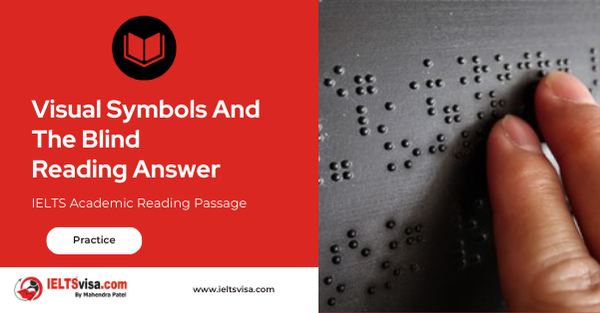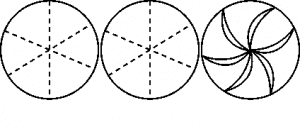Visual Symbols And The Blind Reading Answer
IELTS Academic Reading Passage
Part 1
From a number of recent studies, it has become clear that blind people can appreciate the use of outlines and perspectives to describe the arrangement of objects and other surfaces in space. But pictures are more than literal representations.
This fact was drawn to my attention dramatically when a blind woman in one of my investigations decided on her own initiative to draw a wheel as it was spinning. To show this motion, she traced a curve inside the circle (Fig. 1). I was taken aback. Lines of motion, such as the one she used, are a very recent invention in the history of illustration. Indeed, as art scholar David Kunzle notes, Wilhelm Busch, a trend-setting nineteenth-century cartoonist, used virtually no motion lines in his popular figures until about 1877. Fig. 1
When I asked several other blind study subjects to draw a spinning wheel, one particularly clever rendition appeared repeatedly: several subjects showed the wheel’s spokes as curved lines. When asked about these curves, they all described them as metaphorical ways of suggesting motion. Majority rule would argue that this device somehow indicated motion very well. But was it a better indicator than, say, broken or wavy lines – or any other kind of line, for that matter? The answer was not clear. So I decided to test whether various lines of motion were apt ways of showing movement or if they were merely idiosyncratic marks. Moreover, I wanted to discover whether there were differences in how the blind and the sighted interpreted lines of motion.
To search out these answers, I created raised-line drawings of five different wheels, depicting spokes with lines that curved, bent, waved, dashed and extended beyond the perimeter of the wheel. I then asked eighteen blind volunteers to feel the wheels and assign one of the following motions to each wheel: wobbling, spinning fast, spinning steadily, jerking or braking. My control group consisted of eighteen sighted undergraduates from the University of Toronto.
All but one of the blind subjects assigned distinctive motions to each wheel. Most guessed that the curved spokes indicated that the wheel was spinning steadily; the wavy spokes, they thought, suggested that the wheel was wobbling; and the bent spokes were taken as a sign that the wheel was jerking. Subjects assumed that spokes extending beyond the wheel’s perimeter signified that the wheel had its brakes on and that dashed spokes indicated the wheel was spinning quickly.
In addition, the favoured description for the sighted was the favoured description for the blind in every instance. What is more, the consensus among the sighted was barely higher than that among the blind. Because motion devices are unfamiliar to the blind, the task I gave them involved some problem solving. Evidently, however, the blind not only figured out meanings for each line of motion, but as a group they generally came up with the same meaning at least as frequently as did sighted subjects.
Part 2
|
Words associated with circle/square |
Agreement among subjects (%) |
|
SOFT-HARD |
100 |
|
MOTHER-FATHER |
94 |
|
HAPPY-SAD |
94 |
|
GOOD-EVIL |
89 |
|
LOVE-HATE |
89 |
|
ALIVE-DEAD |
87 |
|
BRIGHT-DARK |
87 |
|
LIGHT-HEAVY |
85 |
|
WARM-COLD |
81 |
|
SUMMER-WINTER |
81 |
|
WEAK-STRONG |
79 |
|
FAST-SLOW |
79 |
|
CAT-DOG |
74 |
|
SPRING-FALL |
74 |
|
QUIET-LOUD |
62 |
|
WALKING- STANDING |
62 |
|
ODD-EVEN |
57 |
|
FAR-NEAR |
53 |
|
PLANT-ANIMAL |
53 |
|
DEEP-SHALLOW |
51 |
Fig. 2 Subjects were asked which word
in each pair fits best with a circle and which with a square. These percentages show the level of consensus among sighted subjects.
We have found that the blind understand other kinds of visual metaphors as well. One blind woman drew a picture of a child inside a heart – choosing that symbol, she said, to show that love surrounded the child. With Chang Hong Liu, a doctoral student from China, I have begun exploring how well blind people understand the symbolism behind shapes such as hearts that do not directly represent their meaning.
We gave a list of twenty pairs of words to sighted subjects and asked them to pick from each pair the term that best related to a circle and the term that best related to a square. For example, we asked: What goes with soft? A circle or a square? Which shape goes with hard?
All our subjects deemed the circle soft and the square hard. A full 94% ascribed happy to the circle, instead of sad. But other pairs revealed less agreement: 79% matched fast to slow and weak to strong, respectively. And only 51% linked deep to circle and shallow to square. (See Fig. 2.) When we tested four totally blind volunteers using the same list, we found that their choices closely resembled those made by the sighted subjects. One man, who had been blind since birth, scored extremely well. He made only one match differing from the consensus, assigning ‘far’ to square and ‘near’ to circle. In fact, only a small majority of sighted subjects – 53% – had paired far and near to the opposite partners. Thus, we concluded that the blind interpret abstract shapes as sighted people do.
Questions 1-3
Choose the correct letter, A, B, C or D.
Write your answers in boxes 1-3 on your answer sheet.
1. In the first paragraph the writer makes the point that blind people
A may be interested in studying art.
B can draw outlines of different objects and surfaces.
C can recognise conventions such as perspective.
D can draw accurately.
2. The writer was surprised because the blind woman
A drew a circle on her own initiative.
B did not understand what a wheel looked like.
C included a symbol representing movement.
D was the first person to use lines of motion.
3. From the experiment described in Part 1, the writer found that the blind subjects
A had good understanding of symbols representing movement.
B could control the movement of wheels very accurately.
C worked together well as a group in solving problems.
D got better results than the sighted undergraduates.
Questions 4-6
Look at the following diagrams (Questions 4-6), and the list of types of movement below.
Match each diagram to the type of movement A-E generally assigned to it in the experiment.
Choose the correct letter A-E and write them in boxes 4-6 on your answer sheet.

4………………… 5………………… 6…………………
A steady spinning
B jerky movement
C rapid spinning
D wobbling movement
E use of brakes
Questions 7-13
Complete the summary below using words from the box. Write your answers in boxes 7-13 on your answer sheet. NB You may use any word more than once.
In the experiment described in Part 2, a set of word 7…………………. was used to investigate whether blind and sighted people perceived the symbolism in abstract 8…………………. in the same way.
Subjects were asked which word fitted best with a circle and which with a square. From the 9…………………. volunteers, everyone thought a circle fitted ‘soft’ while a square fitted ‘hard’.
However, only 51% of the 10…………………. volunteers assigned a circle to 11…………………. When the test was later repeated with 12…………………. volunteers, it was found that they made 13…………………. choices.
|
associations |
blind |
deep |
hard |
|
hundred |
identical |
pairs |
shapes |
|
sighted |
similar |
shallow |
soft |
|
words |
|
|
|

Solution For: Visual Symbols And The Blind Reading Answer
- C 8. shapes
- C 9. sighted
- A 10. sighted
- E 11. deep
- C 12. blind
- A 13. similar
- pairs 14. B
Review and Practice
- Regularly practice with IELTS reading samples and time yourself to get used to the pressure of the exam.
- Review your mistakes to understand where you went wrong and how to avoid similar errors in the future.
Our Books
Master IELTS Speaking Part 1
IELTS Writing Task 1 Book
IELTS Writing Task 2 Book
Visual Symbols And The Blind Reading Answer Explanation
Comin Soon
Practice IELTS Other Modules
IELTS Listening
The IELTS Listening test assesses how well you can understand spoken English in various contexts. It lasts about 30 minutes and is divided into four sections with a total of 40 questions. The listening tasks become increasingly difficult as the test progresses.
IELTS Academic Reading
The IELTS Academic Reading section assesses your ability to understand and interpret a variety of texts in academic settings. It is designed to evaluate a range of reading skills, including skimming for gist, reading for main ideas, reading for detail, understanding inferences, and recognizing a writer's opinions and arguments.
IELTS Speaking
The IELTS Speaking test assesses your ability to communicate in English on everyday topics. It lasts 11-14 minutes and consists of three parts: introduction, cue card, and a discussion based on the cue card topic.
IELTS General Reading
IELTS General Reading tests your ability to understand and interpret various types of texts. Here are some key areas and types of content you can expect to encounter in the reading section, along with tips for effective preparation.
IELTS Academic Writing Task 1
In IELTS Academic Writing Task 1, you are presented with a visual representation of information, such as graphs, charts, tables, or diagrams, and you are required to summarize, compare, or explain the data in your own words.
IELTS General Writing Task 1
In IELTS General Writing Task 1, you are required to write a letter based on a given situation. The letter can be formal, semi-formal, or informal, depending on the prompt. Here’s a breakdown of the key components to include in your letter
IELTS Academic Writing Task 2
In IELTS Academic Writing Task 2, you are required to write an essay in response to a question or topic. Here’s a guide to help you understand the essential elements of this task
IELTS Exam Tips
To succeed in the IELTS exam, practice regularly, familiarize yourself with the test format, improve your vocabulary, develop time management skills, and take mock tests to build confidence.
Grammer for IELTS
Grammar is the foundation of effective communication in English. Understanding tense usage, subject-verb agreement, and sentence structure enhances clarity and coherence in writing and speaking.
Vocabulary for IELTS
Vocabulary plays a crucial role in the IELTS (International English Language Testing System) exam, especially in the Speaking and Writing sections. Here’s an overview of why vocabulary is important and how it impacts your performance
RECENT IELTS SAMPLES QUESTIONS AND ANSWERS
Becoming An Expert Reading Answer
A Expertise is commitment coupled with creativity. Specifically, it is the commitment of...
STUDY CENTRE COURSES Reading Answer
SELF-STUDY TIPS AHowever difficult you find it to arrange your time, it will pay off in the...
The Extrinct Grass In Britain Reading Answer
A The British grass interrupted brome was said to be extinct, just like the Dodo. Called...
Morse Code Reading Answer
A. A new satellite-based system is being implemented to replace Morse code for sending...
Magnetic Therapy Reading Answer
AMagnetic therapy, which is a $5-billion market worldwide, is a form of alternative medicine...
Lack Of Sleep Reading Answer
Section A It is estimated that the average man or woman needs between seven-and-a-half and...













